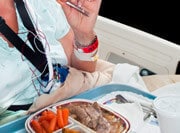
Efficient renovations in Wichita
Foodservice Director magazine reports that the Kansas Heart Hospital in Wichita completed $250,000 worth of food facility renovations with great success in summer 2012. Prior to these upgrades, the cafeteria and kitchen had not seen any significant improvements since the hospital opened in 1999.
Rather than demolish the old space or knock down walls to expand the area, the majority of the renovation funds were dedicated completely to revamping the existing area – about 2,500 square feet of floor space. Not only did this plan work to focus the project on new design elements and equipment, but it was also one of the key selling points for cost-conscious hospital administrators.
While the original dining area was designed to support Kansas Heart Hospital’s initial 23-bed layout, it has since been updated to handle the facility’s modern 54-bed design. Furthermore, the cafeteria also caters to local Wichita residents, handling between 350 and 450 transactions every day. New additions to the kitchen include an updated refrigeration unit, freezer, sinks and food preparation area. Additionally, the cafeteria layout has been shifted for seamless traffic flow for greater patient satisfaction.
Combining food services in Florida
Healthcare organizations operating in Florida have also been working to enhance their local food service operations. According to Food Management magazine, healthcare cooperative LeeSar developed a large, multi-faceted facility in Ft. Myers, Florida. The structure was opened in 2012 in order to meet the needs of Florida hospitals and healthcare organizations with a centralized food and pharmaceuticals operation.
The food processing area of the building is known as Culinary Solutions and primarily serves Lee Memorial Hospital. However, all members of the LeeSar cooperative can gain access to Culinary Solutions’ meal plan.
Hospital food service managers who want to optimize their dietary choices and meal plans for patients may want to consider investing in healthcare software solutions as well as new kitchen equipment. By diverting hospital funds into improving the overall quality of food, technology and procedures used in their healthcare organization’s cafeteria, managers can vastly improve the overall efficiency and enjoyment of services by patients, staff and visitors.







